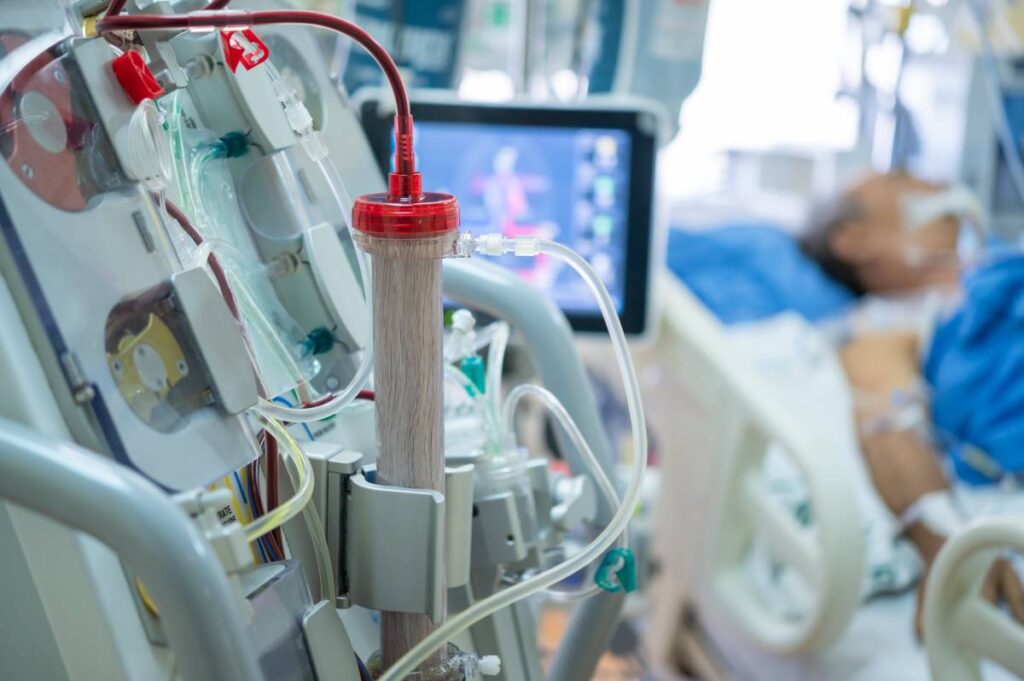Extracorporeal membrane oxygenation (ECMO) is a life-saving technique that provides temporary support for patients with severe cardiac or respiratory failure (or both) [1,2]. It is implemented in cases where no other treatment is likely to be successful and all other options have been exhausted [2]. In recent years, ECMO has become increasingly common in critical care settings and has even found its place in the field of anesthesia.
Often described as a modification of the cardiopulmonary bypass circuit routinely used in cardiac surgery, ECMO functions by removing deoxygenated blood from the venous system and returning oxygenated blood back to the body [1,2]. There are two main subtypes of ECMO: veno-arterial (VA) ECMO and veno-venous (VV) ECMO, which differ in the type of organ support offered to the patient [2]. In veno-arterial (VA) ECMO, the patient receives full cardiac and respiratory support [1]. Deoxygenated blood can be removed either peripherally via cannulation of the femoral vein or centrally via cannulation of the right atrium [2]. This blood is then carried through a circuit consisting of a pump, an oxygenator, and a heat exchanger [2]. Carbon dioxide is removed from the blood and oxygen is added, then the blood returns to the patient’s body either peripherally via the femoral artery or centrally via the ascending aorta [2]. On the other hand, in veno-venous (VV) ECMO, the patient only receives respiratory support [2]. The technique of VV-ECMO is very similar to that of VA-ECMO, except that blood is returned to the body via a large vein [2].
The utilization of ECMO in anesthesia has several implications for the perioperative management of patients. One key aspect is the potential for providing ECMO as a bridge to lung or heart transplantation [7]. Recent studies examining the use of ECMO as a bridge to lung transplantation have found that it significantly improved survival rates compared to conventional mechanical ventilation [7]. This highlights the importance of considering ECMO as a viable option in patients awaiting transplantation.
Moreover, ECMO has been utilized during high-risk surgical procedures, allowing for improved management of hemodynamic stability and gas exchange. These two elements are critical parts of anesthesia care. A study by Zangrillo et al. (2013) investigated the use of ECMO during lung resection surgery and demonstrated that it reduced the risk of intraoperative complications and facilitated postoperative recovery [3]. By providing temporary support to failing organs, ECMO allows for complex surgical procedures to be performed with greater safety and efficacy [3].
ECMO has also shown promise in the management of acute respiratory distress syndrome (ARDS), a condition characterized by severe respiratory failure [4]. Recent literature has evaluated the impact of ECMO on mortality rates in severe ARDS patients, and evidence suggests that ECMO when compared to conventional mechanical ventilation can improve mortality rates due to its ability to stabilize gas exchange and hemodynamic compromise [5,6]. Therefore, ECMO has the potential to improve outcomes in critically ill patients with ARDS, including those undergoing anesthesia for surgical procedures.
In summary, ECMO has started to play a significant role in the field of anesthesia, providing temporary support to failing organs during high-risk surgical procedures and improving outcomes in critically ill patients. Its ability to serve as a bridge to organ transplantation and efficacy in managing severe ARDS makes it a valuable tool in the perioperative setting. Further expansion of the use of ECMO requires a multidisciplinary approach and close collaboration between various healthcare professionals.
References
- Taylor, M., & Maldonado, Y. (2016). Anesthetic management of patients on ECMO. Extracorporeal Membrane Oxygenation: Advances in Therapy, 241.
- Marasco, S., Lukas, G., McDonald, M., McMillan, J., & Ihle, B. (2008). Review of ECMO (extra corporeal membrane oxygenation) support in critically ill adult patients. Heart, Lung and Circulation, 17, S41-S47.
- Zangrillo, A., Landoni, G., & Biondi-Zoccai, G. et al. (2013). A meta-analysis of complications and mortality of extracorporeal membrane oxygenation. Critical Care and Resuscitation, 15(3), 172-178.
- Singh, S., & Hote, M. (2021). Ventilatory management of patients on ECMO. Indian Journal of Thoracic and Cardiovascular Surgery, 37, 248-253.
- Aokage, T., Palmér, K., Ichiba, S., & Takeda, S. (2015). Extracorporeal membrane oxygenation for acute respiratory distress syndrome. Journal of intensive care, 3, 1-8.
- Wieruszewski, P., Ortoleva, J., Cormican, D., & Seelhammer, T. (2023). Extracorporeal Membrane Oxygenation in Acute Respiratory Failure. Pulmonary Therapy, 9(1), 109-126.
- Gulack, B., Hirji, S., & Hartwig, M. (2014). Bridge to lung transplantation and rescue post-transplant: the expanding role of extracorporeal membrane oxygenation. Journal of thoracic disease, 6(8), 1070.
